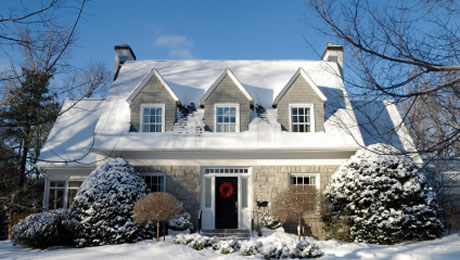Winter Storm Home Repairs

The “Winter of 2014” is one that folks will be talking about for some time. Record snowfalls, brutal temps, freezing rain, ice storms, power outages, and high winds devastated much of the country. In addition to all of those headaches, millions of American homes were left a little worse for wear after Old Man Winter’s repeated visits.
The tricky part about putting things back in order after severe bouts of punishing weather is that some problems are not so obvious. Of course, the usual stuff such as burst pipes, collapsed roofs, and downed tree limbs are par for the course, other issues are more difficult to detect. In this post, we will review a few post-winter storm repair issues that every homeowner should be aware of.
Compromised trees and shrubs
This winter’s ice storms wreaked havoc on trees and shrubs. Limbs made heavy with ice, bent and snapped and sickly trees suffered from excessive amounts of moisture retention. After all the downed limbs are cleared away, closely examine any of your property’s large trees for cracked limbs or split trunks. If neglected, damaged trees could fall on power lines or your home’s roof. Another concern is that fungi, termites or other pests may set up camp in the sickly trees!
Roof and gutters
These are the parts of your home that typically take the brunt of a winter storm. Ice, snow, and strong winds are some of your roof’s worst enemies. The weight of snow and ice can result in structural damage and wind gusts can tear away shingles. Of course any of those scenarios can open the door to leaks and even more problems like mold, mildew, and rot.
In the wintertime, gutters are vulnerable from freezing and swelling, which may lead to cracking or splitting. Another gutter issue is due to a phenomenon known as an “ice dam”. Ice dams occur when the snow melts and refreezes as ice near the edge of the roof. This prevents proper drainage in the gutters and allows moisture to seep under the roof, causing water damage.
Damaged Pipes
Experienced homeowners know that when the thermometer drops to 32F or below, it’s time to take precautions so pipes don’t freeze. When pipes freeze, the home’s water supply is cut off and even worse, the swollen pipes may burst, which causes real issues. If you suspect that your property’s plumbing was jeopardized this past winter, have an experienced plumber check them out. Even small leaks or slow, tiny drips can lead to huge structural problems, mold, mildew, and rot.
Siding
A home’s siding material, regardless of whether it is vinyl, wood, or stucco, experiences trauma from heavy winds, rain, and frozen precipitation. Bent, indented, cracked or missing sections of siding are a red flag that need an immediate response. Unless you are an experienced carpenter, call in a professional to assess and repair the damage.
Home’s Exterior
After the roof, gutters, and siding have been carefully inspected, take the time to go over your home’s exterior components. Of special concern are doors and windows. Repeated severe weather, like the many encores of this year’s Polar Vortex, can cause a continuous cycle of freezing, expanding, and thawing, which may result in structural damage. Homes with a good amount of wood trim will need a thorough check to ensure there are no cracks or other problems that allows moisture in. Of course not taking the time to address these possibilities can lead to expensive restoration projects later.
Furnaces and Heating Systems
Running a home’s heating systems continuously produces an above average amount of wear and tear – not to mention expense! If your home’s furnace, HVAC, or other system has been pushed to the limit, have the unit checked out by a professional who specializes in the type of system your home uses. They may even be able to identify ways you can cut down on the high price of heating your home next winter!
Other Posts You Might Like:
- Did Severe Winter Weather Affect Home Sales?
- Things to Consider When Buying a Fixer Upper
Subscribe To Our Newsletter
Sign up with your email address to receive news and updates.